Men's magazines: an A to Z
Men's magazines, lad's magazines, glamour magazines, pin-up magazines and top-shelf magazines covered alphabetically. This page addresses the magazines Ice to London Opinion, via Lilliput, Loaded and London Life. On other pages:- Introduction
- 3D titles to Boys Toys
- Carnival to Cut
- Deluxe to Esquire
- Fable to Front
- The Gentleman's Magazine to The Humorist
- Ice to London Opinion (this page)
- Man to Maxim
- Mayfair to Monkey
- Nine to Playboy
- Razzle to Stuff
- T3 to Zoo Weekly
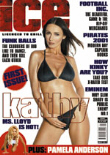 Ice first issue of the men's magazine in 2001. Later covers became
even more racey. The one below features 'Pammi', Pamela Anderson
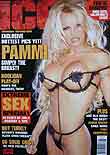 |
Ice / So / Switched On [2001-07]Ice Publications / Galaxy. 2001-2007In 2001, Ice appeared from its eponymous publisher. Its covers became more and more indistinguishable from top-shelf titles. It branded itself 'The men's magazine for real men.' Ice was sold on to top-shelf men's publisher Galaxy, and they tried to revamp the title and take it more upmarket as a mainstream magazine – out went the 'babes' and in came gadgets. However, the title could not shake off its downmarket image. So, in 2007, the magazine was relaunched with the title So – Switched On. However, this only lasted for three issues and was closed in April. The title lived on for a while as a website. |
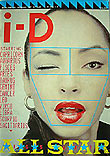 I-D with singer Sade on the cover for February 1984 |
i-D [1980-]Levelprint / Vice, 1980-Style magazine that has outlived all its competitors. A feature of the cover is that all the subjects are shown with one eye closed or covered (a visual pun on the smiley-like title i-D). Issues are usually themed: skin, happiness, scratch and sniff. Publisher Terry Jones has published a book about the magazine: I-Dentity: An Exhibition Celebrating 25 Years of I-D Curated by Terry Jones. Dylan Jones became editor of i-D in 1984. He worked on The Face and Arena and is now editor of GQ in the UK. i-D website |
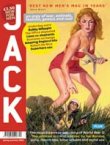 Jack: first issue of James Brown's compact format men's magazine
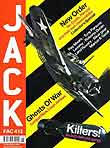 Jack: January 2003 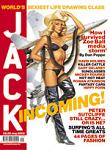 Jack: April 2003 |
Jack [2002-04]IFG / Dennis, 2002-August 2004After bemoaning the state of the men's market, James Brown, launch editor of Loaded and former editor of GQ, set up his own company, I Feel Good, and launched film magazine Hot Dog. Then, in 2002, he put his reputation on the line in launching a men's quarterly, Jack. It took the A5 ‘handbag’ format popularised by women's glossy Glamour. It described itself as ‘an orgy of war, animals, fashion, genius and cool’ and ‘another great British men’s mag with lions instead of lager.’ However, Jack failed to achieve substantial sales and, with an ABC of about 33,000 copies, IFG was taken over by Dennis in autumn 2003. Jack was relaunched for its November issue in a larger, sub-A4, format (176mm wide by 255mm – 8mm wider and 29mm taller). However, this did not work either and Jack closed in August 2004, selling fewer than 40,00 copies. IFG profile Dennis profile |
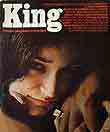 King: first issue dated winter 1964 funded by Paul Raymond. He pulled out and the next issue was March 1965; it was monthly from June 1965 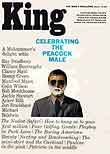 King: July 1966 cover feature 'Celebrating the peacock male' illustrated with a photograph of the magazine's designer, Dave Chaston 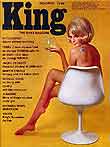 King: November 1966 issue featured actor Terry Thomas talking to director Michael Winner 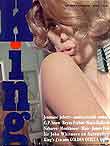 April 1967 issue was selling almost 70,000 copies a month. Jeannine Jubert was the colour centre spread and James Fox modelled the suits |
King [1964-68]Bunny Publications (part of the Paul Raymond Organisation – first issue); Europress, winter 1964-1968Paul Raymond himself introduces the first issue of King: 'King is financed in part by the money that sophisticated men have spent at the Raymond Revuebar and the Celebrité, and the purpose of this magazine is quite frankly to enlarge on the style of adult enjoyment I know men like.' The magazine's title appears to have been a personification of Raymond: the magazine refers to ' the King, his various lieutenants and the girls of the Raymond Revuebar'. It was seen as England's answer to Playboy and illustrations editor Michael Foreman had been art director of Playboy in Chicago. To save money, the first issue of King used 21-year-old editorial assistant Jo Brooker as the cover girl. She was wearing an 18-carat gold ring commissioned from Frank Clark of the King symbol. According to an obituary of journalist John Sandilands in the Telegraph: 'Raymond baled out after the first issue, and Peter Sellers, Bryan Forbes, Bob Monkhouse, David Frost and others were persuaded to invest to keep it going.'They set up Europress as the publishing company. There, staff included:
There was fiction in the form of 'The Changeling' by Ray Bradbury illustrated by Anthony Smart, 'The Magic Coffin' by Michael Baldwin and 'Exterminator!' by William Burroughs; Paul Cantrell covered surfing in Cornwall; Clancy Signal asked: Will Playboy [the club] work in Mayfair?; a two-page cartoon strip by Michael Foreman of a golf game between Sean Connery, Charlie Drake, Harold Wilson and Harold Macmillan, interrupted by George Brown. Michael Caine donned his Harry Palmer persona for a guide to Berlin, and Acker Bilk talked to Alfred Mann. King ran colour nudes from the start. The April 1967 issue had an ABC certified sale of 69,878 copies. However, it was swamped by the likes of Bob Guccione's Penthouse and was taken over by Mayfair in 1968. |
KO! [not launched]Code name for men's magazines that was reported to be in development in 2005 by Daily Express and OK! publisher Northern & Shell.Northern & Shell profile |
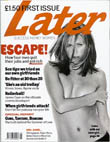 Later: Loaded strategy for 30-plus men |
Later [1999-2001]IPC, 1999-June 2001Later took the Loaded lads magazine strategy to a 30-plus readership under editor Phil Hilton. Failed to catch on. Closed with sales reported at below 50,000. IPC profile |
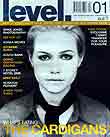 Level aimed to come out six times a year with music as its core offering |
Level [1999-?]4130 Publishing, Brighton. April/May 1999-?Editor Chris Quigley put together a mix of people, style, music, film, travel, life and adventure – a mix of 'all things good' that aimed to create 'a brand new hope'. Unfortunately, from the editor's letter it seems obvious that the publishers weren't clear about what Level was and wanted to do. Music was important, though, with pieces on hip hop and a cover interview with The Cardigans. 4130 profile |
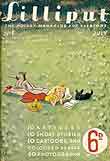 Lilliput first issue. The cover was by Trier, who always featured a man,
a woman and a scottie dog 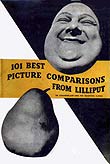 Compilation book of Lilliput juxtapositions photographs by Stephan Lorent 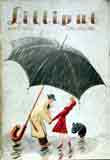 Lilliput in its heyday (1946) 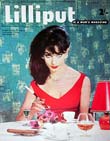 Lilliput in its days as a men's magazine (February 1958) 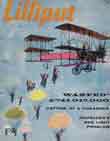 The last issue (July 1960) – it was taken over by Men Only |
Lilliput [1937-60]Pocket Publications/Hulton Press/Longacre Press, July 1937-July 1960Lilliput was launched under editor Stefan Lorant as 'The pocket magazine for everyone' (stapled, 136x196mm). Hungarian-born Lorant had made a name for himself on the Münchner Illustrierte Presse, but was jailed for six months when Hitler came to power. He came to the UK and ran Weekly Illustrated for Odhams before branching out with Alison Blair. Lilliput was intended for a general audience but became a men's magazine after the second world war. Sales of the first issue were estimated at 150,000. At sixpence, Lilliput was half the price of the similarly-sized Men Only. The title was soon bought by Hulton who let Lorant go on to create Picture Post. Lilliput was a bestseller in its day, famous for its mix of photographs, reportage, fiction, cartoons and an occasional artistic nude. Particularly popular were its picture comparisons, where two photographs were printed on opposite pages with captions that drew comparisons (see below). In 1940, Lorent compiled some of these into a book (left). The title on the dust jacket was 101 Best Picture Comparisons from Lilliput: Or Chamberlain and the Beautiful Llama; inside, it was Chamberlain and the Beautiful Llama and 101 more juxtapositions. The introduction describes how a picture of Rockefeller as a poor old man and another of a happy peasant triggered the idea for the first issue: 'The first issue of Lilliput appeared and we found that what people liked most in the magazine were just these few photographic jokes.' The concept evolved and the 'idea behind the idea' became to debunk, 'to show how stupid pomposity, how silly self-importance is'. Lilliput was selling about 102,000 copies under Hulton in May 1959. In July 1960, it was merged into Men Only. Many issues have a page describing the contributors, who included people such as actor James Mason, Antonia White, Ronald Searle and Tom Driberg. Among the people who worked on Lilliput were Jocelyn Stevens, whose uncle, Sir Edward Hulton, owned the title. Kaye Webb, who joined Lilliput in 1938 and was assistant editor from 1941 until she left in 1947 to marry the cartoonist Ronald Searle, edited the book Lilliput Goes to War, which was based on clippings and photos from the magazine (Hutchinson, 1985). 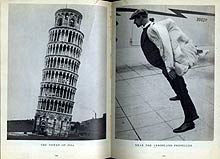 Example of Lilliput juxtapositions |
Line [2002]Time Life Ent. Group Ltd, Spring 2000Line was a sports fashion magazine launched by Wallpaper founder Tyler Brûlé. It used two covers: male and female models. Line failed to build on Wallpaper's success and was closed. IPC profile |
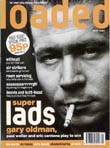 Loade established the lads' magazine sector that has spread around the world
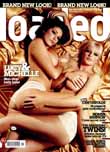 Relaunch in May 2005 with a DVD of Lucy Pinder and Michelle Marsh, a price cut and a redesign were designed to protect sales from the new weeklies, Nuts and Zoo |
Loaded [1994-2015]IPC Media / Vitality Publishing (from late 2010), May 1994-2015Loaded defined a 'laddish' culture that was ground-breaking and was to reverberate around the world. On television, the same laddish element was seen in BBC programmes such as the sitcom Men Behaving Badly, the sports quiz They Think It's All Over and the irreverent news quiz Have I Got New for You (in which one of the teams was led by Private Eye magazine editor Ian Hislop). Other TV presenters and stand-up comics were part of the trend, such as Paul Merton and Frank Skinner (who was featured on the cover of issue 6 – 'Nudge, nudge, wink, wink: Frank Skinner's world of smut'). A couple of photographs of up-and-coming actress Elizabeth Hurley, an article on hotel sex and a competition to win a dirty weekend in Brighton's Grand Hotel (scene of the IRA's bomb attack on Margaret Thatcher's Conservative party a decade earlier) were as far as the first issue of Loaded went. Founding editor James Brown wrote a regular editor's letter entitled 'page three', a reference to the Sun tabloid newspaper, which had become famous for its topless women on that very page. In the first issue, Brown wrote: 'What fresh lunacy is this? Loaded is a new magazine dedicated to life, liberty and the pursuit of sex, drink, football and less serious matters. Loaded is music, film, relationships, humour, travel, sport, hard news and popular culture. Loaded is clubbing, drinking, eating, playing and eating. Loaded is for the man who believes he can do anything, if only he wasn't hungover.' Of course, this is too long for a front cover, so it became 'For men who should know better.' There were variations on this: 'For men who should know letter' for a July 1995 cover on David Letterman; and '...snow better' for the January 1995 cover showing Santa being knicked. The first issue sold 59,400 copies and Loaded broke the 100,000 sales barrier with its ninth issue, its lads magazine formula overtaking the fashion-based Arena and GQ in the process. Its first audited yearly sales figure was 96,000 – and this rose by 82% to 174,763 for the period Jul-Dec 1995. Brown went on to edit GQ and found Jack at IFG. Loaded deputy editor Tim Southwell (and founder of Golf Punk) described the magazine's early days in his book Getting Away with It (Ebury, 1998). In October 2010, IPC sold Loaded to Vitality as part of a sale of several 'niche' titles. |
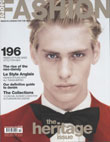 Loaded Fashion was relaunched as Fashion Inc |
Loaded Fashion [closed]Most of the big men's titles have tried to move into the upmarket fashion niche, launching Arena Homme Plus, FHM Collections and Loaded Fashion. These met with limited success. Loaded Fashion was relaunched as Fashion Inc in spring 2006.IPC profile |
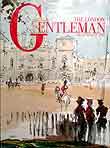 London Gentleman was a free men's magazine distributed to central
London homes. Above is the July/August 1985 issue |
London Gentleman [closed]Viewstead Ltd. mid-1980sThe London Gentleman was published 10 times a year and distributed free to '200,000 selected homes within a 30-mile radius of central London'. Viewstead was a member of the European Courtesy Magazines Group. The editorial was based on the darker side of English sports, sparked by the Heysel stadium disaster. Customer magazine publishers |
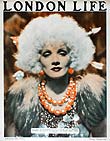 London Life with a stunning cover of Marlene Dietrich in the film Blonde Venus (20 Jan 1934). This was a black and white picture that was very skilfully coloured and printed. London
Life was fond of punny cover lines, such as: 'Her first flying lesson ... at the Serpentine
lido' and 'Another "panky" portrait on page 21'. Another was: ‘Little
man you’ve had a busy day, by 'Mounted mannequin'.
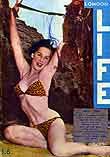 London Life in May 1960 as a pocket format men's magazine |
London Life [1922-60]New Picture Press, London. 1922-1960 (at least). Weekly, then fortnightly and monthlyLondon Life was a mixture of bathing suit pin-ups sprinkled among copious letters pages full of fetishistic correspondence illustrated with readers' drawings and photographs about corsets, stockings, high heels and artificial limbs. The covers often took black and white photographs and added spot colour or duotone and occasional use of silver ink. It also changed its masthead every issue. A feature was often made of the middle four pages, which were printed on a coated, thicker paper. The result was a gloriously produced weekly and classic of art deco design and high-quality printing. Before the second world war, London Life was published at a larger than A4 size (9.5 x 12.5 inches), but paper rationing saw it cut down to a smaller format in 1941 (7.5 x 9.75). In October that year, the cover carried a warning that paper controls meant it had to reduce further to a 'magazine size', in this case pocket size (4.75 x 7.25), from the next issue and also go fortnightly. Furthermore, its Fleet Street offices were bombed and it moved out to Reading, though later returning to a London address in the Strand. After the war, it adopted a slightly larger pocket format (5.25 x 7.25) with spot colour and later four-colour outer covers; however, it never regained the glory of its pre-war days. London Life was printed by Keliher, Hudson & Kearns, Hatfields, London SE1. By May 1960, London Life ran to 52 pages for 1/6 and featured a supplement about the occult.The title London Life was also used by Tatler in 1965-67 (London Life / Tatler) and for a pornographic title in 1977. London Life magazine front covers 1920-1960 |
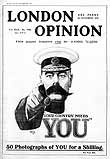 This London Opinion cover has to be one of the most influential covers ever published 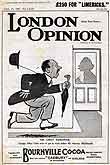 London Opinion still used mono covers in 1924 (no 1039). The caption to the unsigned cartoon read: 'Foreign Office clerk tries to get to work before Mr. Ramsey MacDonald.' 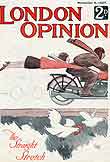 By 1927, colour was being used on the front (an Alfred Leete illustration) and the back cover carried a colour advert for Player's Navy Cut 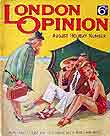 London Opinion during the first year of the second world war. The cartoon caption on the cover of this August holiday issue reads: 'Hello Fred! I got your card saying you wished I was here!' 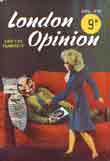 London Opinion and The Humorist (Nov 1945) 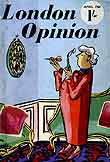 April 1954 – last issue before Men Only merger |
> | London Opinion [1903-54]London Opinion Ltd / Pearson (Newnes), 26 December 1903-27 June 1939; July 1939-April 1954. Weekly till 1931; then monthlyLondon Opinion started as a men's weekly. The first issue was 'conducted' by A. Moreton Mandeville and cost 1d for eight pages. There was no advertising. Quite how it survived is difficult to imagine from the first issue – pure text (much of it garbled) in three columns a page unrelieved by any illustration and just 3 or 4 sideheads. It was printed on newsprint. The content was a first person ramble around Rome, Thibet [sic], Yorkshire, Should women play golf?, errors in foreigners speaking English, Dickens and Thackeray and Russia. The final page was half-filled with advice on renewing oilcloth and cooking recipes! It was printed by Odhams Ltd, 19-24 Floral St, Covent Garden, London WC2 (near the Lamb & Flag pub!). However, survive it did, bringing in cartoons and much more varied content. It used large black-and-white cartoons on its cover before adopting colour illustrations in the late 1920s. By 1914 it was also insuring readers for up to £1,000 (a popular tactic with magazines and newspapers since Victorian days). The printer was Love & Malcolmson Ltd, Dove St, High Holborn. The publisher was London Opinion Ltd, Watergate House, York Buildings, the Adelphi. It still costs 1d. The summer annual cost 1/-. A September 1914 cover by Alfred Leete inspired the famous 'Your country needs you' poster of Lord Kitchener. London Opinion introduced spot colour on its covers in 1925. There was a Christmas special in 1927 with a full-colour cover and these 6d specials became more frequent, with Easter, Whitsun and summer editions as well. London Opinion was a 2d weekly until it reduced its frequency to monthly in late 1931 and raised the price to 6d. In the spring of 1931, it introduced a jaunty new masthead, though it reverted to the old style when it went monthly. The magazine used an A4-ish format (7¼" x 9½") until it was relaunched in 1939 in a pocket digest format (as Men Only had been since 1935). This was described as a move to a more popular size, but Newnes might have had paper rationing in mind with the onset of war. London Opinion took over the weekly Humorist in 1940 and carried that title as part of its masthead until 1950. It used a formula of stories, cartoon and photographs – including a couple of artistic nudes. The November 1945 issue of London Opinion published a photograph of a woman wearing a headscarf on which was printed the cover of Men Only from October 1942 (showing a cartoon of a Russian sailor). The picture caption read: 'Just a "babushka" turns Pat into Patrushka.' (One meaning of babushka being a headscarf.) In 1950, the Economist criticised the closure of the Strand while London Opinion and Men Only continued (although published under the C. Arthur Pearson imprint, the company had been controlled by George Newnes since 1914). Among the famous names who cut their teeth in the magazine were Keith Waterhouse, who had his first published article in London Opinion in 1954 at the age of 15, and Norman Thelwell, the cartoonist famed for his strips about a girl and her dimwitted pony, who ran a series – 'Sweetie-Pies of Other Days' starting in March 1949. Dennis Gifford has described London Opinion at this time as 'probably the funniest magazine of its era'. The last issue was April 1954, when London Opinion was taken over by Men Only. The issue carried a 16-page colour section promoting the changes and the introduction of Vargas pin-ups. Men Only made no mention of the merger in its April issue, the editorial only promoting the 'Raft of despair' real-life adventure serial. London Opinion and the best magazine cover ever Men Only profile |
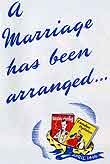 Opening page of a 16-page colour section promoting the merger of London Opinion and Men Only |
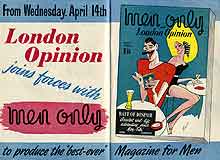 The May 1954 issue of Men Only promised to take in the best features of both monthlies |
|
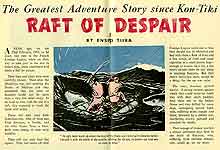 Adventure-based fiction was an important element of magazines at this time |
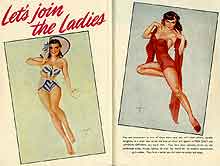 The Let's Join the Ladies pin-up feature in Men Only had recruited the US illustrator Vargas
|
|
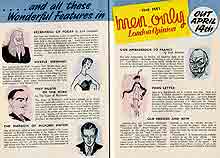 Features such as 'Ecentrics of today' by the judge Lord Hailsham, The Adventures of that Naughty Girl Myrtle were seen as very popular |



